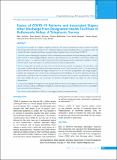Please use this identifier to cite or link to this item:
https://hdl.handle.net/20.500.14356/1101| Title: | Status of COVID-19 Patients and Associated Stigma After Discharge from Designated Health Facilities of Kathmandu Valley: A Telephonic Survey |
| Authors: | Shrestha, Bikal Shrestha, Dhan Bahadur Budhathoki, Pravash Neopane, Arun Kumar Dangol, Suman Shrestha, Sailendra Kumar Duwal Mandal, Jenny |
| Citation: | ShresthaB., ShresthaD. B., BudhathokiP., NeopaneA. K., DangolS., Duwal ShresthaS. K., & MandalJ. (2021). Status of COVID-19 Patients and Associated Stigma After Discharge from Designated Health Facilities of Kathmandu Valley: A Telephonic Survey. Journal of Nepal Health Research Council, 19(2), 277-283. https://doi.org/10.33314/jnhrc.v19i2.3376 |
| Issue Date: | 2021 |
| Publisher: | Nepal Health Research Council |
| Article Type: | Original Article |
| Keywords: | Anxiety disorders COVID-19 social stigma survivors treatment outcome |
| Series/Report no.: | Apr-June, 2021;3376 |
| Abstract: | Abstract Background: COVID-19 is a highly contagious viral disease. The anxiety, misinformation about COVID-19, and the fear of being infected by the virus have led to widespread stigma in local communities. Thus, we conducted a study to evaluate the status of patients and disease-associated stigma of patients who recovered from COVID-19. Methods: Status of discharged/ improved COVID-19 individuals were followed after their discharge within 2 months after COVID-19 status through telephonic interview. Data of interview was recorded in excel sheets, which was imported in Stata v. 15. Simple descriptive analysis performed and finding presented in appropriate tabulation. Further binomial logistic regression analysis was performed for post-treatment stigmatization. Results: Among 365 case details retrieved, 262 cases contained contact details. Among them, 221 total phone calls were made, of which only 94 could reach for phone interview. 50 (53.19%) were male; 59 (62.77%) were married; and 85 (90.43%) were Hinduism by religion. Majority (n=74, 78.72%) were asymptomatic. The average hospital/isolation stay of patients was 11.23±4.75 days. Among interviewed individuals, 24 (25.81%) reported some type of stigmatization. Individuals with comorbidities and tested for travel purpose has less chance of stigmatization comparing than others. Higher the age in years and longer the duration of hospital/isolation stay; higher the odds of having stigmatization. Conclusions: High level of stigma was seen among COVID-19 survivors. The stigma associated with COVID-19 was shown to increase with age and length of hospital stay while the stigma decreased with the presence of co-morbidities and was tested for travel purposes. Keywords: Anxiety disorders; COVID-19; social stigma; survivors; treatment outcome |
| Description: | Original Article |
| URI: | http://103.69.126.140:8080/handle/20.500.14356/1101 |
| ISSN: | Print ISSN: 1727-5482; Online ISSN: 1999-6217 |
| Appears in Collections: | Vol. 19 No. 2 (2021): Vol 19 No 2 Issue 51 Apr-Jun 2021 |
Files in This Item:
| File | Description | Size | Format | |
|---|---|---|---|---|
| 3376-Manuscript-23763-1-10-20210907.pdf | Fulltext Download | 261.1 kB | Adobe PDF |  View/Open |
Items in DSpace are protected by copyright, with all rights reserved, unless otherwise indicated.
